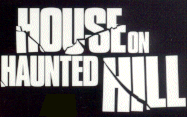

No,
there wasn't a glowing skeleton on a wire.
Or
so those of you who read my review of the original
House on Haunted Hill might ask. Though Robert Zemeckis
and Joel Silver may have formed a production company for the express
purpose of remaking William Castle pictures, they apparently have
no interest in attempting to duplicate Castle's ballyhooing showmanship.
Which is either too bad or a case of both men being remarkably honest
with themselves.
I
don't usually do pictures of such recent vintage, but as I reviewed
the original just as this remake was hitting the theaters, it seems
only natural to address the remake a few weeks after its release to
video. I'll try not to engage in any spoilers - there are a few surprises
that should remain surprises - but instead satisfy myself with comparing
and contrasting the two films.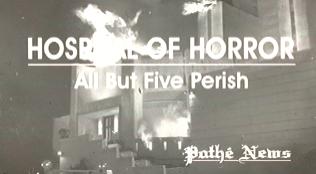
First,
let's find out about the House itself. It seems that it was the Vannacutt
Psychiatric Institute for the Criminally Insane in the 30's, run by
Dr. Robert Vannacutt (Jeffrey Combs), who himself happens to be criminally
insane - as the movie begins, he is eviscerating a patient without
benefit of anesthesia. This no doubt contributes to the inmate uprising
that results in an Island of Lost Souls -type comeuppance for
the deadly doc, but not before he sets in motion a device that literally
locks down the entire building: steel shutters close over every door
and window, and the fires the inmates have set spread and kill everyone
except for five staff members.
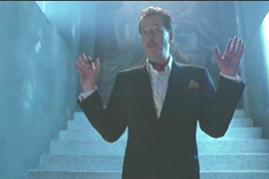 This
is presented as newsreel information (Vannacutt liked to film his
depredations, and the inmates caught his messy death on film), which
in turn is being broadcast on "Terrifying But True!" hosted by Peter
Graves. This is being watched by Mrs. Evelyn Price (Famke Janssen)
from her bubble bath - and she thinks this House on Haunted Hill is
a spiffy place to have her upcoming birthday party, and tells her
hubby, thrill ride designer and amusement park magnate Stephen Price
(Geoffrey Rush) so.
This
is presented as newsreel information (Vannacutt liked to film his
depredations, and the inmates caught his messy death on film), which
in turn is being broadcast on "Terrifying But True!" hosted by Peter
Graves. This is being watched by Mrs. Evelyn Price (Famke Janssen)
from her bubble bath - and she thinks this House on Haunted Hill is
a spiffy place to have her upcoming birthday party, and tells her
hubby, thrill ride designer and amusement park magnate Stephen Price
(Geoffrey Rush) so.
We
can tell that love does not exactly ooze from Stephen and Evelyn's
relationship, and this is confirmed when Stephen shreds her guest
list and manufactures his own. His idea is to offer one million dollars
to anyone surviving the night in the House; his criteria is to invite
people he knows would do anything for money, including enduring
whatever spookhouse tricks he might muster. His criteria also becomes
moot when something reboots his computer and rewrites the guest list.
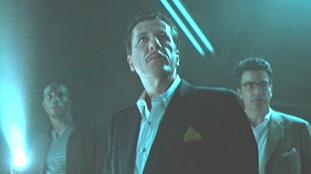 So
four people (Ali Larter, Taye Diggs, Peter Gallagher and Bridgette
Wilson) are met at the front gates by the House's owner, Watson Pritchett
(an extremely twitchy Chris Kattan), who guides them - rather unwillingly
- into the foreboding structure's salon. The eternally warring Prices
are surprised by their guests, though in different ways - Price himself
is sure that Evelyn somehow redirected his guest list. Then the ancient,
rusty shutters slam shut of their own accord, and a million dollars
suddenly doesn't seem like that much money....
So
four people (Ali Larter, Taye Diggs, Peter Gallagher and Bridgette
Wilson) are met at the front gates by the House's owner, Watson Pritchett
(an extremely twitchy Chris Kattan), who guides them - rather unwillingly
- into the foreboding structure's salon. The eternally warring Prices
are surprised by their guests, though in different ways - Price himself
is sure that Evelyn somehow redirected his guest list. Then the ancient,
rusty shutters slam shut of their own accord, and a million dollars
suddenly doesn't seem like that much money....
Geoffrey
Rush makes a very good Vincent Price manqué, especially
astounding since he's actually playing this showman as John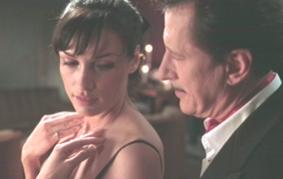 Waters! But put a pencil-thin mustache and a cravat on Rush, and somehow
it comes out Vinnie. Waters is an even better choice as a character
model, and Rush's American accent is impeccable. Famke Janssen is
an appropriately icy beauty in the Carol Ohmart role, though she adds
a surprisingly, thoroughly vicious dimension to Evelyn. The remake
preserves the original's cleverly-written sniping between the two
("arsenic on the rocks" is amended to "the O.J. Simpson
knife with the not-so-retractable blade"), and yet manages to
show that he somehow still cares for her - as Evelyn once points out,
"a sick little scene" indeed.
Waters! But put a pencil-thin mustache and a cravat on Rush, and somehow
it comes out Vinnie. Waters is an even better choice as a character
model, and Rush's American accent is impeccable. Famke Janssen is
an appropriately icy beauty in the Carol Ohmart role, though she adds
a surprisingly, thoroughly vicious dimension to Evelyn. The remake
preserves the original's cleverly-written sniping between the two
("arsenic on the rocks" is amended to "the O.J. Simpson
knife with the not-so-retractable blade"), and yet manages to
show that he somehow still cares for her - as Evelyn once points out,
"a sick little scene" indeed.
Peter
Gallagher assays an M.D., who in the Castle version was a psychiatrist
specializing in cases of hysteria, one of the "amusing"
aspects of the guest list Vinnie kept pointing out. Gallagher's character
is even less well-defined than the others - and we'll get to that
script deficit eventually - but in his case, it's justified.
 The
updated equivalent of the aging gossip columnist in the original is
a younger, out-of-work celebrity hoping to parlay he
The
updated equivalent of the aging gossip columnist in the original is
a younger, out-of-work celebrity hoping to parlay he r
videotapes of the evening into a "wackiest home videos gig". Just
as her 50's version was the only person to encounter truly supernatural
phenomena - blood kept dripping from the ceiling onto her hand, no
matter which room she was in - Wilson, trolling through the foreboding
basement labyrinth for "pure gold", finds that her camcorder can see
Vannacutt and his crew reenacting the vivisection in an empty operating
room... and worse, they can see her.
r
videotapes of the evening into a "wackiest home videos gig". Just
as her 50's version was the only person to encounter truly supernatural
phenomena - blood kept dripping from the ceiling onto her hand, no
matter which room she was in - Wilson, trolling through the foreboding
basement labyrinth for "pure gold", finds that her camcorder can see
Vannacutt and his crew reenacting the vivisection in an empty operating
room... and worse, they can see her.
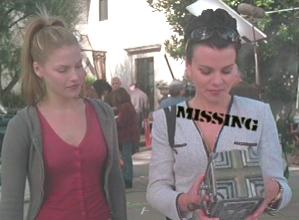 Larter,
in the chick role, has been changed from an office bound secretary
to the assistant of a foul-mouthed, thoroughly hateful movie executive
played by Debi Mazar. What? You don't remember that character? That's
because her major scene was cut for time considerations, but it appears
as a supplement in the DVD
version. In it, Price's booby-trapped invitation literally bites the
executive on the finger, and she fires Larter in a fit of pique. Larter
later fishes the invite out of the trash, and seeing the million dollar
clause, decides to impersonate Mazar. This scene excised, we are left
with an unsatisfying, breathless confession by Larter that breezes
quickly past us - but as every other character's backstory is given
similarly short shrift, I guess we're not supposed to care.
Larter,
in the chick role, has been changed from an office bound secretary
to the assistant of a foul-mouthed, thoroughly hateful movie executive
played by Debi Mazar. What? You don't remember that character? That's
because her major scene was cut for time considerations, but it appears
as a supplement in the DVD
version. In it, Price's booby-trapped invitation literally bites the
executive on the finger, and she fires Larter in a fit of pique. Larter
later fishes the invite out of the trash, and seeing the million dollar
clause, decides to impersonate Mazar. This scene excised, we are left
with an unsatisfying, breathless confession by Larter that breezes
quickly past us - but as every other character's backstory is given
similarly short shrift, I guess we're not supposed to care.
For
instance, Taye Diggs is our handsome, likable guy hero - amusingly,
in the 50's he was the day's idea of a Man of Action, a test pilot
- but here he becomes a "former" pro baseball player. From the way
he ruefully says, "former". You know there's a story there.
Too bad we'll never get it. Diggs is wonderfully likable in the role,
with an easygoing Jimmy Stewart charisma and a  disarming
smile that most matinee stars would kill for.
disarming
smile that most matinee stars would kill for.
The
character most shorted by this myopia toward character development
is Watson Pritchett, played in the 50's by the eternal fall guy, Elisha
Cook, Jr. What we know about this modern version is that his grandfather
built the House, his father was killed during the renovation, and
that he knows far more about the House and it's supernatural denizens
than any person should reasonably know. What is not revealed - except,
once again, on the DVD, during director William Malone's commentary,
is that Pritchett has inherited the house, and though he has been
unable to sell it, he still has to pay the taxes on it, and is thus
living out of his car (though given Pritchett's feelings about the
house, it would seem to be the wiser course of action to just walk
away and let the county take possession). Also, as to his intimate
knowledge of the Bad Things in the House - it turns out his father
died trying to wall up the physical manifestation of the Evil that
occupies the House. We see the half-finished wall several times. Pritchett
comments on it. Malone tells us these things in the space of two sentences.
HOW DIFFICULT COULD IT HAVE BEEN TO GET THOSE TWO SENTENCES IN
THE SCRIPT???
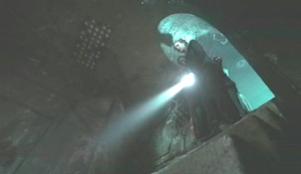 I
suspect that the difficulty lay not so much in the mechanics of the
storytelling process but in the desire to ruthlessly 'modernize' the
story, which means attempting to unfold a horror story in MTV terms.
To reference Malone's commentary track once more, the Mazar scene
was cut in order to "get to the House faster". Thus, we
go directly from the ghostly rewriting of the guest list to the procession
of black limousines crawling up a mountain road to the titular house,
accompanied (to strain the MTV angle a bit) by Marliyn Manson's cover
of "Sweet Dreams". Not that the song is inappropriate -
this segment, in fact, is a small masterpiece of visual storytelling
- but when one recalls that the original employed this sequence for
Price's narration to provide the backstory for each character... well,
why, then, is each character so determinedly a cypher?
I
suspect that the difficulty lay not so much in the mechanics of the
storytelling process but in the desire to ruthlessly 'modernize' the
story, which means attempting to unfold a horror story in MTV terms.
To reference Malone's commentary track once more, the Mazar scene
was cut in order to "get to the House faster". Thus, we
go directly from the ghostly rewriting of the guest list to the procession
of black limousines crawling up a mountain road to the titular house,
accompanied (to strain the MTV angle a bit) by Marliyn Manson's cover
of "Sweet Dreams". Not that the song is inappropriate -
this segment, in fact, is a small masterpiece of visual storytelling
- but when one recalls that the original employed this sequence for
Price's narration to provide the backstory for each character... well,
why, then, is each character so determinedly a cypher?
I
can also crankily assert that the MTV damage can possibly run a bit
deeper, too. One of the things the missing Mazar's  executive
shrieks at a beleaguered film director is "Where are my teens
and tits? How do you expect me to get adolescent boys to see this?"
The answer, of course, is that she need look no further than the movie
she is in; a large part of the modernization process seems to include
a liberal amount of profanity, lots of gore, and some nudity. As for
teens, it goes almost without saying - and a glance at the video case
or movie poster confirms this - that the cast is largely young and
fresh-faced. The truly bad people in House on Haunted Hill
are the older ones - the murder-game playing Prices (Rush is nearly
50 and Janssen is a luscious 36). Our heroes, Larter and Diggs, are
teens in relative terms, if not truly chronological.
executive
shrieks at a beleaguered film director is "Where are my teens
and tits? How do you expect me to get adolescent boys to see this?"
The answer, of course, is that she need look no further than the movie
she is in; a large part of the modernization process seems to include
a liberal amount of profanity, lots of gore, and some nudity. As for
teens, it goes almost without saying - and a glance at the video case
or movie poster confirms this - that the cast is largely young and
fresh-faced. The truly bad people in House on Haunted Hill
are the older ones - the murder-game playing Prices (Rush is nearly
50 and Janssen is a luscious 36). Our heroes, Larter and Diggs, are
teens in relative terms, if not truly chronological.
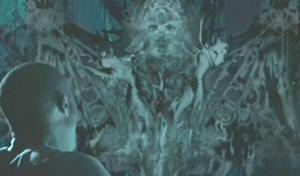 I
had intended, before my MTV digression, to address the subject of
the Evil that rears its ugly head in the last fifteen minutes of the
movie, which is referenced by many as the point at which the movie
sinks itself. (Since I saw the damned thing in the trailer, and on
Entertainment Tonight in the picture's opening weekend, I don't
think this truly qualifies as a spoiler) In the original, there were
no such things as ghosts - at least, not in any sense other than mysterious
drops of blood - but here, in the late 20th century, the collected
spirits of the dead of the Institute are represented by a crawling
Rorschach ink blot of epic and contentious, not to mention carnivorous,
proportions.
I
had intended, before my MTV digression, to address the subject of
the Evil that rears its ugly head in the last fifteen minutes of the
movie, which is referenced by many as the point at which the movie
sinks itself. (Since I saw the damned thing in the trailer, and on
Entertainment Tonight in the picture's opening weekend, I don't
think this truly qualifies as a spoiler) In the original, there were
no such things as ghosts - at least, not in any sense other than mysterious
drops of blood - but here, in the late 20th century, the collected
spirits of the dead of the Institute are represented by a crawling
Rorschach ink blot of epic and contentious, not to mention carnivorous,
proportions.
A
lot of people despise this beastie * - and I
will, as usual, go against the  grain
by saying I liked it (keep in mind that I am also the person who speaks
of the title character of Robot Monster in fond terms). As
an attempt at creating something halfway Lovecraftian, it ain't bad
- but we see far, far too much of it, and when it hovers in place
at the end to menace Diggs, not only does it hold a shape reminiscent
of those old, taxidermied manta rays that used to be passed off in
19th century museums as mermaids, but the visual elements used to
make the ink blot seem a writhing collection of souls become far too
obvious, a movie version of the old game where you stare at the camel
on a pack of its namesake cigarettes until you see the naked woman.
The whole concept and execution of the creature might be more charitably
judged in a much lower budget movie *.
grain
by saying I liked it (keep in mind that I am also the person who speaks
of the title character of Robot Monster in fond terms). As
an attempt at creating something halfway Lovecraftian, it ain't bad
- but we see far, far too much of it, and when it hovers in place
at the end to menace Diggs, not only does it hold a shape reminiscent
of those old, taxidermied manta rays that used to be passed off in
19th century museums as mermaids, but the visual elements used to
make the ink blot seem a writhing collection of souls become far too
obvious, a movie version of the old game where you stare at the camel
on a pack of its namesake cigarettes until you see the naked woman.
The whole concept and execution of the creature might be more charitably
judged in a much lower budget movie *.
The
remake manages to preserve all the plot holes of the original while
contributing its own. I went on at some length in my review of the
original about how it was, effectively, a harmless horror story for
kids. At first blush, this new version has eliminated that aspect
of the story; but in the final act, when we discover the fate of a
character missing for most of the picture, my first 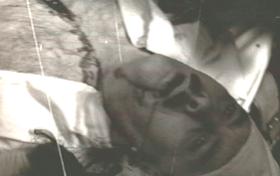 thought
was, that's a bit much. Later, I realized that in concept,
it was reminiscent of the incredibly gross stories we used to chill
each other with around the campfire - and in that way, this new House
at least keeps with the spirit of its predecessor, though deserving
its R rating in spades. Considered in that light, I began to warm
toward it.
thought
was, that's a bit much. Later, I realized that in concept,
it was reminiscent of the incredibly gross stories we used to chill
each other with around the campfire - and in that way, this new House
at least keeps with the spirit of its predecessor, though deserving
its R rating in spades. Considered in that light, I began to warm
toward it.
Oh,
and stick around through the end credits (really, you should be doing
that anyway - each and every one of those people had a mother, you
know)... there's a little something waiting for you on the other side.